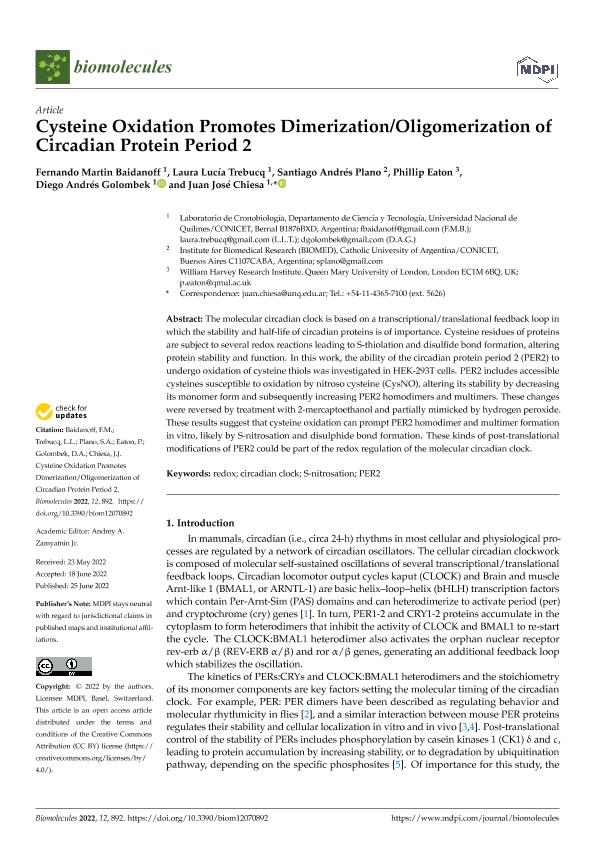Mostrar el registro sencillo del ítem
dc.contributor.author
Baidanoff, Fernando Martín

dc.contributor.author
Trebucq, Laura Lucía
dc.contributor.author
Plano, Santiago Andrés

dc.contributor.author
Eaton, Phillip
dc.contributor.author
Golombek, Diego Andres

dc.contributor.author
Chiesa, Juan José

dc.date.available
2023-07-28T16:03:59Z
dc.date.issued
2022-07
dc.identifier.citation
Baidanoff, Fernando Martín; Trebucq, Laura Lucía; Plano, Santiago Andrés; Eaton, Phillip; Golombek, Diego Andres; et al.; Cysteine Oxidation Promotes Dimerization/Oligomerization of Circadian Protein Period 2; MDPI; Biomolecules; 12; 7; 7-2022; 1-10
dc.identifier.issn
2218-273X
dc.identifier.uri
http://hdl.handle.net/11336/206032
dc.description.abstract
The molecular circadian clock is based on a transcriptional/translational feedback loop in which the stability and half-life of circadian proteins is of importance. Cysteine residues of proteins are subject to several redox reactions leading to S-thiolation and disulfide bond formation, altering protein stability and function. In this work, the ability of the circadian protein period 2 (PER2) to undergo oxidation of cysteine thiols was investigated in HEK-293T cells. PER2 includes accessible cysteines susceptible to oxidation by nitroso cysteine (CysNO), altering its stability by decreasing its monomer form and subsequently increasing PER2 homodimers and multimers. These changes were reversed by treatment with 2-mercaptoethanol and partially mimicked by hydrogen peroxide. These results suggest that cysteine oxidation can prompt PER2 homodimer and multimer formation in vitro, likely by S-nitrosation and disulphide bond formation. These kinds of post-translational modifications of PER2 could be part of the redox regulation of the molecular circadian clock.
dc.format
application/pdf
dc.language.iso
eng
dc.publisher
MDPI
dc.rights
info:eu-repo/semantics/openAccess
dc.rights.uri
https://creativecommons.org/licenses/by/2.5/ar/
dc.subject
CIRCADIAN CLOCK
dc.subject
PER2
dc.subject
REDOX
dc.subject
S-NITROSATION
dc.subject.classification
Otras Ciencias Médicas

dc.subject.classification
Otras Ciencias Médicas

dc.subject.classification
CIENCIAS MÉDICAS Y DE LA SALUD

dc.title
Cysteine Oxidation Promotes Dimerization/Oligomerization of Circadian Protein Period 2
dc.type
info:eu-repo/semantics/article
dc.type
info:ar-repo/semantics/artículo
dc.type
info:eu-repo/semantics/publishedVersion
dc.date.updated
2023-07-27T14:31:37Z
dc.journal.volume
12
dc.journal.number
7
dc.journal.pagination
1-10
dc.journal.pais
Suiza

dc.description.fil
Fil: Baidanoff, Fernando Martín. Universidad Nacional de Quilmes. Departamento de Ciencia y Tecnología; Argentina. Consejo Nacional de Investigaciones Científicas y Técnicas; Argentina
dc.description.fil
Fil: Trebucq, Laura Lucía. Universidad Nacional de Quilmes. Departamento de Ciencia y Tecnología; Argentina. Consejo Nacional de Investigaciones Científicas y Técnicas; Argentina
dc.description.fil
Fil: Plano, Santiago Andrés. Consejo Nacional de Investigaciones Científicas y Técnicas. Oficina de Coordinación Administrativa Houssay. Instituto de Investigaciones Biomédicas. Universidad de Buenos Aires. Facultad de Medicina. Instituto de Investigaciones Biomédicas; Argentina
dc.description.fil
Fil: Eaton, Phillip. Queen Mary University of London; Reino Unido
dc.description.fil
Fil: Golombek, Diego Andres. Universidad Nacional de Quilmes. Departamento de Ciencia y Tecnología; Argentina. Consejo Nacional de Investigaciones Científicas y Técnicas; Argentina
dc.description.fil
Fil: Chiesa, Juan José. Universidad Nacional de Quilmes. Departamento de Ciencia y Tecnología; Argentina. Consejo Nacional de Investigaciones Científicas y Técnicas; Argentina
dc.journal.title
Biomolecules
dc.relation.alternativeid
info:eu-repo/semantics/altIdentifier/url/https://www.mdpi.com/2218-273X/12/7/892
dc.relation.alternativeid
info:eu-repo/semantics/altIdentifier/doi/http://dx.doi.org/10.3390/biom12070892
Archivos asociados
